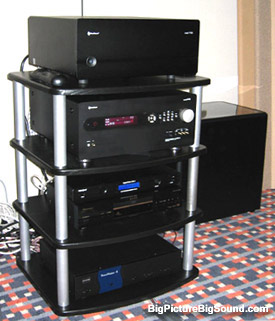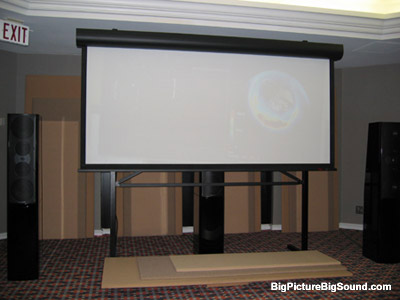Outlaw Releases New LFM-1+ Subwoofer, Teams with Screen Research for Home Theater Demo at HE 2006
By Chris Boylan
Sometimes Bad is Good
Sometimes bad movies make for great demos. Just because a director and/or writer may be asleep at the wheel does not mean that care was not taken by the cinematographers, sound recordists, mixers, foley artists, editors and telecine engineers who piece the film together and bring it home. These guys can turn a so-so story into a visual and audible feast.
In fact, that's what I like most about the second trilogy of "Star Wars" films (Episodes I, II and III), wonderful visuals, superb sound mixing, great music, visual and sound effects as well as painstaking care taken in the transfer to create a stunning blend of eye and ear candy. But without any of that distracting plot or character development stuff. And such was the case in the
Outlaw Audio room this year at Home Entertainment Expo in LA.

The stack 'o gear in the Outlaw room featured an Outlaw preamp/processor and power amps plus a Velodyne room correction unit. Note the LFM-1+ hiding in the background.
Chief Outlaw Peter Tribeman selected a stinker of a film, "The Core" (aka, "the paycheck between Hilary Swank's 2 Oscars") to demo their new improved LFM-1+ subwoofer ($679), an upgraded version of the
LFM-1 that we liked so much last year. As Outlaw has been known to do, they had not one but four LFM-1+ subwoofers in a system comprised of Outlaw electronics, a DVD player, a Dwin projector and one Velodyne SMS-1 ($599) room correction device. Peter spent some time extolling the virtues of the Velodyne piece, which includes a microphone, built-in sound meters, calibration and parametric equalization to tame the bass response in uncooperative rooms. They like it so much they're offering it up for sale on their own Web site, along with the purebred Outlaw gear.
Outlaw Audio, like
Aperion Audio (the speaker company) sells its gear directly to the public so they can pass on the savings in distribution costs directly to the consumer in the form of lower prices. Their specialty is electronics, e.g., receivers, preamp/processors and power amplifiers, but they also offer two subwoofer models as well as cables. Their gear offers not only excellent value, but strong performance as well. Of the Outlaw pieces we have reviewed, the writers (myself included) have all opted to keep the gear after the review, including the
Outlaw 1070 receiver and the
Model 950 preamp/processor. And before the "payola" scandal comes to mind, please be aware that we had to pay for this gear out of our own pockets, albeit at a slight discount over the general public (and I do mean slight)!
But back to the demo... Peter surely selected the scene, where a Space Shuttle is thrown off course and needs to land in the concrete bed of the Los Angeles river, not only as a tribute to the show's venue, but also for its deep extended rumbling bass track that accompanies the shuttle's engine roar and crash landing. The new LFM-1+ was doing just fine, with no hint of strain and excellent extension down to the lowest audible octaves. Improvements in the LFM-1+ over the LFM-1 include more power, and an EQ switch so you can choose between ultra-low extension or higher output. In its "extended" position, the LFM-1+ is down just 2 dB at 18 Hz. Now THAT is what I call low bass!

ScreenResearch screens come in any color you want, as long as you want white.
For the visual side of the demo, Outlaw partnered up with
Screen Research, makers of "acoustically neutral" (as opposed to acoustically transparent) projector screens. Rather than a hard mesh material which can introduce some audio artifacts when speakers are placed behind the screen, Screen Research screens are fabricated of a woven mesh that is sonically neutral - it neither adds nor detracts from the sound. According to the rep, theirs is the first ISF and THX-certified projection screen. The specific screen configuration on display - motorized, in a 100-inch wide size, with an integrated black matte, retails for $6250.
And just as Screen Research believes in sonic neutrality so do they believe in visual neutrality - all of their screens come in matte white finish (not gray) with unity gain (gain of 1). They believe the latest batch of high-end digital projectors, most likely to be paired with these screens offer adequate brightness and contrast so as not to need any assistance in these departments.
The standard definition DVD probably didn't really allow the screen to "stretch its legs" but the screen did present a bright and detailed image in the demo. If is certainly worth consideration for a high-end home theater installation, particularly one in which speakers will be placed behind the screen.

